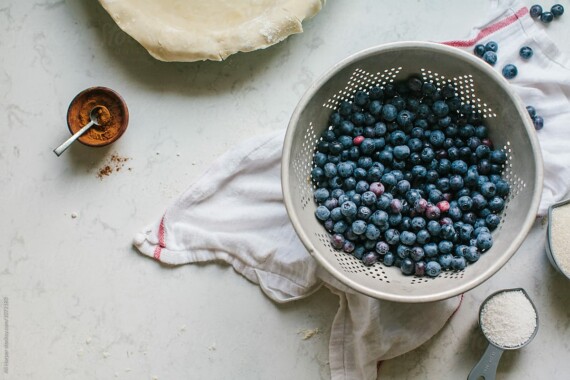In the world of food blogging, it’s all too easy to get wrapped up in what everyone else is doing.
There’s a lot of blanket advice about things that bloggers should do, and it’s tempting to assume that this advice applies to you.
In reality, many SEO recommendations just aren’t right for each and every food blogger. There are general SEO tips and best practices, but every blog has its own niche, technical tool stack, content strategy, and goals. In addition, each author has their own E-E-A-T for SEO (experience, expertise, authoritativeness and trustworthiness).
The best SEO recommendations are the ones that are tailored for your food blog.
This is one of the things we love to work on with community members at Foodie Digital — translating big, broad or crowd-sourced SEO recommendations into individual actions that suit a Foodie Digital community member’s unique situation.
To help you wade through all of the typical advice you hear, we put together a list of 10 blanket SEO recommendations that we often hear about or read about at Foodie Digital that we know from experience don’t actually apply to everyone:
1. Follow a post template formula
You should always write for readers, not robots. Following a post template formula isn’t worth it if it compromises great food writing and supporting your community. The suggestion to follow a post template formula overlooks the value returning readers bring to food blogs
Yes, good post structure matters for readability and the thoughtful use of keywords matter, but fostering community by showing personality also matters.
Otherwise, you’re just another food blog on the internet.
2. Always use a table of contents
You may have heard that you should be using a table of contents in every single post.
But, does this really serve your readers?
Similar to how there isn’t a post template for everyone, not every post needs a table of contents. A table of contents should only be added for longer, comprehensive posts when quickly and easily navigating to new sections would be helpful for the reader.
3. Such and such web host is terrible
We often hear blanket advice that a certain host is terrible, or on the other hand, that a certain web host is the only way to go. In reality, as long as you’re using one of our recommended WordPress web hosts for food blogs and your needs for disk space, bandwidth, and storage are covered, then budget and customer service should dictate your decision making.
4. All of your content should be evergreen
A common recommendation is that all of your content should be evergreen — meaning that it doesn’t have mentions of the time of the year or other timely events. But, depending on what’s in your existing post library and the niche you’re in, it’s OK sometimes if things aren’t evergreen.
It’s common for people to gather to eat at specific holidays and occasions, making seasonal content very meaningful ranking opportunities. Seasonal content — like recipes for Ramadan, Diwali, Hanukkah and Passover and Christmas — or seasonally relevant recipes like holiday sugar cookies or a summer salad or grilling recipes— can also provide value when thoughtfully produced.
Choosing the right seasonal focus is also important. Pumpkin season, for example, usually lasts for 4-5 weeks. Whereas, the fourth of July is just one day a year.
5. Tags should always be no-index
The recommendation to no-index tags is rooted in conserving crawl budget. This is a good idea in theory, but the decision to no-index tags needs to be carefully considered.
Tags can sometimes show-up in themes in a wide range of ways, so it’s important to understand how a decision to no-index them will impact the internal linking structure your site. If you decide to no-index tags, you may need to also remove tags from your post template’s front-end. Also, if you’ve had tags indexed for a long time they may actually be earning you meaningful traffic!
Put simply, it’s a good idea in theory, but some technical inspection is needed to confirm if it’s the right move for you. Several Foodie Digital members have tags intentionally indexed to support their E-E-A-T and subject matter expertise for instance.
6. Your URL structure shouldn’t contain a date
It’s commonly stated that URL structures shouldn’t contain dates. If you’re just starting out or only have 100-200 recipes, it makes perfect sense to remove the date. It’s a fix we do often at FD.
But if you have 800+ posts, the decision to remove the date from the URL needs to be carefully considered. Removing the date from the URL at that stage could create unnecessary risk.
7. Use FAQ schema along with recipe schema
In August 2023, Google announced it will restrict what kinds of sites are eligible to show FAQ rich results in the search results.
Why?
Google is downgrading FAQ rich results to provide users with a cleaner and more consistent search experience and confirmed it will only show FAQ rich results for high-authority websites in the health space and for government websites.
8. An SEO audit improves traffic
Nope! We’ve done so many SEO audits at Foodie Digital and few people’s traffic has improved solely after implementing a handful of audit findings. The only time we see noticeable improvements after onboarding audits is when site speed and performance significantly improves!
Audits exist to find, fix and reduce technical barriers. They serve an important purpose, which is to foster a healthy technical environment where your recipes can be discovered. But, to earn more traffic, you must also do many other things!
To compete as a food blog today, having a fast, technically healthy site that passes Core Web Vitals is important, but just half the battle. Thoughtful, strategic editorial planning is key.
Plus, there’s patience. Even after implementing changes and suggested technical improvements to your blog, things take time. SEO is a slow burn.
9. Use PageSpeed Insights for performance
Did you know that the scores generated by PageSpeed Insights are based on a simulated lab test? And, did you know that the results apply only to a specific URL? Most people just input their homepage URL, but there are separate scores for each URL on your site.
If you want to understand how competitive your site’s Core Web Vitals are, you need to pay attention to field data, not lab data. And the easiest place to check your field data is the Core Web Vitals report in Google Search Console.
10. Add text in your ingredient images
In Google’s Image SEO overview it says:
Don’t embed important text inside images: Avoid embedding text in images, especially important text elements like page headings and menu items, because not all users can access them (and page translation tools won’t work on images). To ensure maximum accessibility of your content, keep text in HTML, provide alt text for images.
Instead, consider adding captions to your images (where it makes sense) to meet web accessibility guidelines, and of course, always write image alt text too.
Anything else you want us to chime in on? Comment below!
Note: Foodie Digital participates in affiliate programs for select recipe card plugins and hosting providers. The opinions we share are based on our own in-depth research, and the ongoing need for our members to use SEO tools that are future-proofed, credible, professional and well supported.












